 Leading Blog | Posts by Month |
 Leading Blog | Posts by Month |
11.30.18

LeadershipNow 140: November 2018 Compilation
See more on
Posted by Michael McKinney at 11:40 AM
11.26.18

Leading Matters: John L. Hennessy on the Leadership Journey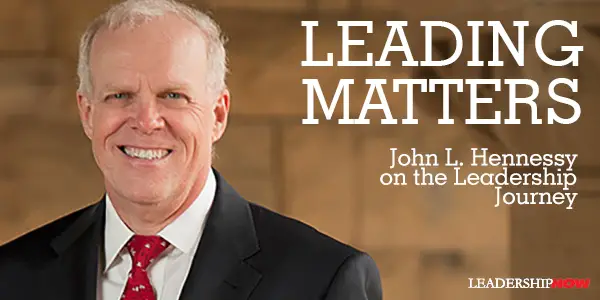
A Leading Matters is about the journey. The stories he tells here are revolve around the ten elements that shaped his journey and how he relied on these traits in pivotal moments. The elements are relevant to any leader at any level. As he observes, the higher up you go the crises just get bigger and come faster.
Here are some of his thoughts on each element extracted from his stories: Humility A true sense of one’s own skills and character—arises not from ego, but from humility. Arrogance sees only strengths, ignores our weaknesses, and overlooks the strengths of others, therefore leaving us vulnerable to catastrophic mistakes. Leading with humility means letting others announce your accomplishments because you don’t need to, it means realizing and openly admitting that your understanding might not be right, it means taking the opportunity to learn from mistakes, and it means stepping up to the moments that challenge and grow you. Authenticity and Trust Authenticity is essential to building trust. Consider the wisdom popularly attributed to Socrates: “The way to a good reputation is to endeavor to be what you desire to appear.” It’s a start down the path to a deeper practice of authenticity—you must identify those good and true characteristics you admire, and then you must work to embody them. So this is part of the practice: identify the virtue you admire, strive to embody them, and be humble about the journey—you probably aren’t there yet. In fact, just when you think you’ve arrived, life has a way of returning you back to the beginning. Leadership as Service The larger one’s leadership role becomes, the bigger the role of service in that leadership. If you take a leadership role as a step toward a personal goal of gathering ever-greater titles, awards, and salaries, you will never see true success in that role. Recognize the service of others. As a leader it is easy to get wrapped up in big projects and ambitious initiatives, and, in the process, to forget the smaller, but no less important, individual acts of service taking place all around you. Much of that service supports and enables the widely celebrated success of others. Empathy Empathy should always be a factor in making decisions and setting goals. Empathy represents a crucial check on action—placing a deep understanding of and concern for the human condition next to data can lead to decisions that support the wellbeing of all. Empathy usually implies compassion and perhaps charity, but we are looking for more than that: we are looking for the kind of empathy that changes people as a result of their interactions with each other, the kind of empathy that arises when one sees the world anew through someone else’s eyes. Courage Humility, authenticity, empathy, service-mindedness—these characteristics shape a leader’s vision and chart a course toward right action. Courage, on the other hand, compels a leader to take that right action. While many people can discern what is right and true, acting on that discernment is more difficult. Even if risk-taking is against your nature, for the good of your organization, you must find the courage to practice it. Collaboration and Teamwork Most significant endeavors will be accomplished by a team. Certain ground rules circumvented interteam rivalries. First of all, I reminded everyone of our shared goal: we wanted to achieve something great. Further, to support innovative, cross-disciplinary thinking, I set a second ground rule: at the start, we don’t criticize ideas. To this, I added a third ground rule: tough questions aren’t only allowed, they are necessary. This led to my final ground rule: team members must be treated with the utmost respect. Innovation I can’t tell you how many times I’ve had this conversation with students: the student opens with, “I want to create a start-up.” I ask them to tell me about their technology, and they answer, “Well, I don’t have it yet, but I want to do a start-up.” I remind these students that great start-ups begin with great technology discoveries. Innovation presents great opportunities for smart entrepreneurs, not the other way around. Intellectual Curiosity Beyond personal enjoyment, though, this lifelong curiosity has served me well in my career. It has enabled me to engage in meaningful dialog about the world and its future. Literature, biographies, and histories—they’re like laboratories in which we can examine and learn critical lessons without having to live the difficulties ourselves. In challenging moments, great leaders show their true character. …Their stories taught me if you can’t take the blame for failure, you shouldn't take the job. Storytelling If you really want to inspire a team to action, best to engage them with a story. Once they become receptive—once they can imagine themselves as part of your vision—you can back your story up with facts and figures. When you turn that dream into a vivid story, you make it so attractive and so real that people will want to share it with you by joining your team. When it came time to respond to change, these companies moved quickly and efficiently, because every employee already understood the company identity and therefore knew how to respond without direct coaching. In every profession and career, as we climb to higher leadership positions, the role of facts and data decreases. Legacy Instead of worrying about my legacy too much or too early, I’m choosing now—as I always have—to follow the path of making meaningful contributions. Legacy means the institution serves people more effectively now than it did when you arrived. 
Posted by Michael McKinney at 02:08 PM
11.23.18

Farsighted: How We Make the Decisions That Matter the Most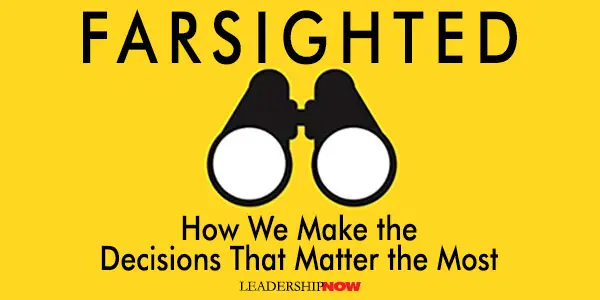
L Some choices are easy like “Should I get vanilla or chocolate ice cream?” Most of our decisions are like this, and the consequences aren’t life-changing. Most books on decision-making describe these kinds of intuitive, gut-reaction decisions. But not all decisions are of this type. Some are farsighted choices as Steven Johnson calls them in Farsighted: How We Make the Decisions That Matter the Most. These are the big decisions—life choices—like should I move to Denver? Should I take that job? Should I move home? Should I buy that car? Should I buy the house? Should I get married? How do we make the right choice in these kinds of decisions? The answers are rarely a clear yes or no. These are complex problems with multiple variables. We are all familiar with Benjamin Franklin’s two-column method. Most of us just tally the number of items on each list and go with the longer list. But Franklin recommended an important final step in this process. He advised that you conduct a kind of “Prudential Algebra” to each entry to give them relative weight because not all reasons are of equal value. It makes good sense, but as we know, sometimes it works, and sometimes it doesn’t. What we need is “a routine or a practice—a specific set of steps for confronting the problem, exploring its unique properties, weighing the options.” A deliberate and measured approach that allows you to think about a problem from multiple perspectives. Johnson puts forth a three-step method “designed specifically to overcome the unique challenges of a hard choice.” All decisions have a context, perspectives, and possible consequences. This method helps to address each of them. The method begins with building a full-spectrum map of all of the variables and the potential paths available to us. Then we make predictions about where all those different paths might lead us, given the variable at play. Finally, we decide on a path by weighing the variable outcomes against our overarching objectives. Given our disposition towards scientific methods, we would like this to be scientific to remove the human weaknesses that challenge our decision-making. But as Tolstoy’s Prince Andrew counseled in War and Peace, “What theory and science is possible about a matter the conditions and circumstances of which are unknown and cannot be defined, especially when the strength of the acting forces cannot be ascertained?” The Prince continued, “What science can there be in a matter in which, as in all practical matters, nothing can be defined and everything depends on innumerable conditions, the significance of which is determined at a particular moment which arrives no one knows when?” Mapping We all use mental maps whether we know it or not. The trick is to be intentional about it. “What the map should ultimately reveal is a set of potential paths, given the variables at play in the overall system. Figuring out which path to take requires other tools.” In the mapping step, you are looking to expand the context of your decision to include all possible decision paths. The art of making farsighted decisions “with as much wisdom as possible lies not in forcing that map to match some existing template, but instead in developing the kind of keen vision required to see the situation as it truly is. And the best way to develop that vision is to get different pairs of eyes on the problem.” It requires a bit of humility as well. You are more likely to be right to the degree that you recognize that you may be wrong. We must embrace the likely possibility that we are wrong to get it right. Often what stands in our way of getting it right is our certainty that we are right. The lesson: explore other alternatives. Predicting When we make a farsighted decision, we are predicting what will happen as a result of our decision. But that’s not easy. One of the problems we run into is assuming that things will continue as they always have—the fallacy of extrapolation. Things changes and we don’t know what we don’t know. As Nobel laureate Thomas Schelling once noted that one thing a person cannot do “is to draw up a list of things that would never occur to him.” To make good decisions, we need to make those kinds of imaginative leaps. Johnson prescribes simulations to do just that. Engaging in scenario planning or gaming is not to make accurate predictions, but “the very act of trying to imagine alternatives to the conventional view helps you perceive your options more clearly.” Pierre Wack wrote in the Harvard Business Review, “No single ‘right’ projection can be deduced from past behavior. The better approach, I believe, is to accept uncertainty, try to understand it, and make it part of our reasoning.” It is a kind of storytelling. We create stories around our decisions all the time—“when we do this, this is what it will be like.” And that’s good. The problem arises when we fail to construct multiple stories around our choices. “That doesn’t always give you a definite path, but it does prepare you for many ways the future might unexpectedly veer from its current trajectory.” With the decision mapped, the options identified, and the scenarios panned, it’s time to decide. Deciding Making a decision is the final step. How do we decide? What’s best for me or what’s best for the greater good or some other cost-benefit analysis. If we’ve done the first two steps well and given ourselves an appropriate amount to process, often the decision becomes clear. “But sometimes the answer is murkier, and you have to make the tough call between a few remaining options, each of which promises a different mix of pain and pleasure to the individuals affected by the choice.” Almost every strategy described in this book ultimately pursues the same objective: helping you see the current situation from new perspectives, to push against the limits of bounded rationality, to make a list of things that would never occur to you. They’re designed to get you outside your default assumptions, not to give you a fixed answer. While Johnson presents many strategies and ideas of real value, the magic of Farsighted is the examples he weaves throughout to make the ideas and principles come alive. Of Related Interest: 
Posted by Michael McKinney at 04:14 PM
11.22.18

Happy Thanksgiving from LeadershipNow
W Happy Thanksgiving! We owe so much to so many. It was Ralph Waldo Emerson who said, “Cultivate the habit of being grateful for every good thing that comes to you, and to give thanks continuously. And because all things have contributed to your advancement, you should include all things in your gratitude.” Thank you! Here are links to posts on gratitude from here and around the web:
Posted by Michael McKinney at 09:53 AM
11.21.18

How to Bring Gratitude into the Workplace
‘Tis the season of gratitude -- for friends, for family, and for delicious turkey dinners. But what about gratitude in the workplace? November and December are notorious times for organizations to express gratitude to their employees -- holiday parties, annual bonuses, and accolades they save up for this time of year. And while these gestures are appreciated, the truth is gratitude should be practiced all year round. By focusing on giving thanks just one time a year, these overtures become less authentic, and thus less meaningful. For leaders, practicing gratitude at work is an incredibly valuable tool, and one that shouldn’t be saved for a single season. Here are a few suggestions you can implement today and use all year long, from the most personal, to the most public:
We all benefit when we take a minute to step back and recognize the good people and things we have in our lives. Study after study shows that gratitude is a key factor in happiness. While we don’t often combine a gratitude practice with work, as you can see there are some easy ways to do just that. Giving thanks feeds the soul, which is as necessary in November as it is in February or June. 
Posted by Michael McKinney at 09:11 AM
11.19.18

William Donaldson on Entrepreneurial Leadership
W Donaldson and Karl Weber extract relevant lessons for leaders in Entrepreneurial Leader. The thread that runs through his career is the entrepreneurial mindset. That mindset is “about the application of creative thinking and prudent risk-taking to build innovative, long-lasting organizations in any sector of the economy.” There are leaders and there are entrepreneurs, but not all leaders are entrepreneurs, and not all entrepreneurs are leaders. Simply put, I believe that entrepreneurial is a mindset—a way of thinking—and leadership is a way of acting. Entrepreneurial leadership, then, describes the way such a leader behaves. The case method he experienced at the Harvard Business School, showed him that “in many cases, the deeper you delve into a problem, the less obvious the answers are.” This realization is empowering because “since nobody really knows the one perfect solution to the kinds of real-life challenges organizations face, it’s important to have the courage to ask questions, to propose answers, to challenge assumptions, and to experiment—all of which are key elements of the entrepreneurial drive.” As founding dean and professor at the Yale school of management, he taught a course on entrepreneurial leadership. He focused on the personal characteristics of the leader. “Of course, an entrepreneurial leader needs to know about subjects like financial management, competitive strategy, market analysis, and the like. But I think those topics are distinctly secondary. More important are the human qualities that the entrepreneurial leader brings to the job—the ability to see the world through fresh eyes; the ability to pay attention to both the big picture and the small details that define a particular situation; a high degree of personal energy, optimism, and a sense of fun; the readiness to shape and define the system in which he or she operates rather than being controlled by a system someone else has created; and, most important, a strong sense of integrity.” By integrity, he means that they transcend themselves. They look beyond their ego. They remain true to the vision and commit to the value of individuals. He notes that an entrepreneur is not a gambler. “The smart entrepreneur uses careful planning, intelligent strategy, and lots of hard work to minimize the risk as much as possible.” Effective leaders must be entrepreneurial—which means getting things done, regardless of the obstacles. I found this comment especially useful as it speaks to the mission here at LeadershipNow: In the business arena, entrepreneurial leaders must think and behave as if they own the company—whether they do or not. Entrepreneurial leaders must define systems rather than be defined by them; they must adopt an ownership mentality. They understand that they must take ownership of their choices, including the smaller, day-to-day decisions they make. They must take full responsibility for them rather than attributing them to “the system” or “circumstances.” Entrepreneurial leaders also think continually about the big picture—the broader goal that everyone in the organization is supposed to be working toward—and strive to be guided not by short-term gain or personal profit but by long-term objectives that help everyone. Furthermore, entrepreneurial leaders find ways to encourage everyone in the organization to think and behave in this way, and create circumstances that help them do this. The behind-the-scenes look at the roles he has taken on throughout his life—especially the rationale behind and the building of Donaldson, Lufkin & Jenrette—is instructive. The range of his life and career demonstrate the broad relevance of the principles he describes in this book and makes for a fascinating read. 
Posted by Michael McKinney at 12:43 PM
11.16.18

Leading Views: Humility is the X-factor in Great Leaders
Shigeru Miyamoto is arguably the greatest video game designer, developer, and producer in history. He has worked for Nintendo since 1977. Miyamoto has helped create some of the greatest and most enduring franchises of all time, including Super Mario Brothers, Donkey Kong, The Legend of Zelda, and the Wii series of games. 
Posted by Michael McKinney at 12:17 PM
11.14.18

The 8 Elements of Punk Rock Business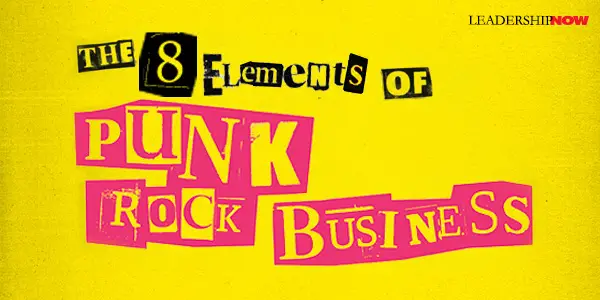
O The title of Jeremy Dale’s book, The Punk Rock of Business, comes from a comment Bono made to Oprah about a project Dale was working on with him for Motorola. Dale and his team had performed the impossible and Bono said, “They are the punk rock of business: no long introductions, three beats and you’re in. They say they are going to do something, and then it just gets done.” Using that as an inspiration, Dale has taken it to mean so much more. Punk is an attitude. It’s a fight against apathy and complacency. “I’m not okay with the current status quo. We’re into disruption.” Many businesses these days are clogged up by bureaucracy that thwarts innovation, slows down creativity, and encourages mediocrity. I hate mediocrity. I’d much rather have spectacular success or fantastic failure. I believe mediocrity occurs far too often because too many people in business, particularly those in middle-management roles, are far too cautious, pessimistic, and more concerned about protecting their jobs rather than striving for greatness and being everything they could be. They are fearful of putting their heads above the parapet, so they take a play-it-safe attitude and come up with the conservative, tame, and expected proposals. Dale has distilled the punk rock movement to eight elements. These 8 elements of Punk Rock Business were at the heart of punk rock music, movement, attitude, fashion, and culture. Elements that are wanting in many organizations. Element 1: Have a Cause “Punk was all about wanting something better, being clear about what that was, and making that their cause.” Have a point of view. Find something you’re passionate about and then inspire your team to deliver it. An organization’s mission statement is meant to direct every single decision. A mission statement may not be enough. You may need to create a manifesto to add substance and emotion, creating a story around the mission statement. “We should be committed to being a lighthouse brand; that is, one who shines brightly, whose position is fixed so that people can navigate their world trusting in us and our position on things.” Well put. Element 2: Build a Movement “Punk was attractive to like-minded people, and it galvanized that segment of the youth. Punk, more than music, was a mindset, and that attracted people.” It’s all about the people. The followers make the movement. You must get other people on board. Show your commitment to them and the mission by showing up. This is where you bring your emotional brain and not your rational brain. Element 3: Create New and Radically Different Ideas “Punk was completely different—never seen before jaw-dropping creation that exploded into our consciousness. No one was ambivalent to punk; you loved it or hated it.” It’s about creating new, different, and better ideas. After all, that’s what leadership is. Punk provided an avenue to express their frustration with the dead-end society that they saw at the time. “Never before had music been played at anything like two hundred beats per minute. Never before had music been played so loudly or aggressively. Never before had the lyrics to the songs been so politically charged or laid siege to taboo subjects.” Begin by finding out what’s different about what you’re doing. What problem are you trying to solve? Radical ideas come from teams. And when they do they need to be brought to life by showing, not telling. Radical ideas are targets and so need to be protected. “Every project should have a vision and some nonnegotiables. The nonnegotiables are so important, because not only do they prevent the willingness to compromise, they also act as the catalyst for intelligent people to seek creative solutions when the inevitable challenges arrive.” Element 4: Drive Speed and Action “Punk was three beats, and you’re in.” Go for it. “When time is tight, great things happen.” You don’t always have to be right. “Decision-making is a portfolio. Not every decision needs to be correct.” The momentum is the important thing. Element 5: Say It as It Is “Punk lyrics came with a contagious honesty.” No nonsense. You have to say it like it is—but constructively. Sometimes you have to call others out, and sometime you must call yourself out. Don’t leave people wondering what you think. Speaking plainly saves time, bring clarity, and sets the performance bar where you want to set it. Element 6: Be Authentic “Punk gave people permission to be themselves.” Probably the only rule of being punk is: “to be yourself and be comfortable being who you are.” Surround yourself with confidants who will hold you accountable and call you out when you are being a fraud. Element 7: Put Yourself Out There “To be punk you had to make a very visible and belligerent statement; it required you to put yourself out there, say ‘this is me,’ and invite criticism. It was far more important to just give it a go, rather than to get it perfect.” Grab every opportunity to challenge yourself. Be the first to volunteer. You will be criticized. Get used to it. “You will not always get it right, but my experience is that the impact you have when you do get it right far outweighs the embarrassment when you don’t.” Are you a participant or a spectator? Element 8: Reject Conformity “Punk pressed the reset button.” Nonconformist. “However, it wasn’t just its nonconformity, it was the extent to which it didn’t conform that was shocking for many.” Some norms are pointless and irrelevant. “Today’s corporate world is full of mediocrity, slowness, politics, false praise, and people too scared to say it as it is. More and more employees are disillusioned with lukewarm leadership that makes their jobs dull and boring and constrains their creativity, imposing limitations rather than empowering them.” Don’t take yourself too seriously. “Get over the show, get over your ego, and react based on the quality of work, not the superficial stuff that doesn’t matter.” Joey Ramone said they started a band because in 1974 everything was overproduced. “Being overproduced and perfectly organized kills the lifeblood that spontaneity brings.” Humility is the X-Factor “Punk by its very nature is aggressive and in your face.” Humility keeps you out of trouble. “Punk doesn’t need to be aggressive if you apply a degree of care and humility. If people see that you are fundamentally a good person, whose heart is in the right place, whose motives are pure, who has charm and charisma, who isn’t arrogant or conceited, who cares about people, and above all else is human and has humility, then you can apply all eight elements without worrying if you’re going too far.” Dale adds fifteen more key requirements that are needed to implement a punk rock attitude in business. Unfortunately, I have not conveyed in this commentary the great stories that are used throughout to illustrate the 8 Elements of Punk Rock of Business. They are engaging and entertaining and really help to develop the concept. Well worth the read. The book provides a much-needed perspective on business and leadership in a very unconventional way. 
Posted by Michael McKinney at 07:14 PM
11.13.18

quickpoint: Artificial Intelligence and What is an Entrepreneur
“Technology doesn’t solve humanity’s problems. It was always naïve to think so. Technology is an enabler, but humanity has to deal with humanity’s problems. I think we’re both over-reliant on technology as a way to solve things and probably, at this moment, over-indexing on technology as a source of all problems, too.” CEO of Google, Sundar Pichai in New York Times, 11.08.18
Posted by Michael McKinney at 10:19 AM
11.12.18

Six Essential Practices to Grow Your Leadership
T It is in this spirit that the authors state, “the best way for any aspiring leader to succeed and to navigate turbulent times is to tune out the noise and refocus on these fundamentals” of leadership. They define leadership as “Achieving significant positive impact—by building an organization of people working together toward a common goal.” The Harvard Business Review Leader’s Handbook is designed to help you grow your leadership. It is organized around six practices. While not meant to be all-encompassing, these are areas that “differentiate those who have the strongest impact.” Naturally, an understanding of human nature—the so-called soft skills—makes these six practices exploitable. The six practices are practical and provide a useful guide taking responsibility to lead and improve your effectiveness. Building a Unifying Vision Organizational success requires a bold and compelling vision that brings people together and inspires them to achieve extraordinary results. The vision needs to be exciting, clear, and simple—and stakeholders should be involved in its creation. Developing a Strategy Implementing a strong, measurable strategy is the key to realizing a vision. A great strategy is composed of key actionable choices about what to do, and what not to do to create distinctive value. Strategies are iteratively developed in the context of the company’s audience, challenges, and opportunities. Getting Great People on Board Smart and dedicated people help bring strategies to life. Executing strategies skillfully begins with recruiting, developing, and retaining high-performing talent. People need feedback to grow and incentives to feel recognized. Focusing on Results The experience of achieving short-term results motivates teams to strive for even more. Setting high expectations and sharpening accountability is necessary for high performance. Sold metrics and reviews can help this process become an organized one. Innovating for the Future Balancing current performance while investing for tomorrow is a key for enduring success. By keeping an eye on the demands of the future, leaders can continually drive innovations that will reshape the company to keep up with a changing world. Leading Yourself In order for leaders to lead others, they need to know and grow themselves. Feeling healthy, energized, and balanced also helps leaders do their best work. Leaders need to raise their own bar—in turn they’ll raise it for their organization. Grasp the Leadership Opportunity Already In Your Reach The authors make a good point. You shouldn't wait to be anointed a leader. Step up and take the responsibility now. Seizing the leadership opportunity and making the leadership difference in fact requires courage and also an ability to look beyond the every day and near-term tasks of basic management.… To be a leader, you need to anticipate like a great chess player who looks ten moves ahead and also quickly adjusts to the opponent’s play. 
Posted by Michael McKinney at 07:02 PM
11.09.18

Take Charge of Your Company’s Future
H The fundamental problem we face say the authors of Leading Transformation—Nathan Furr, Kyle Nel, and Thomas Zoega Ramsoy—is our tendency toward incremental thinking. That is “to see and act on what is nearby, easy to access, and familiar than what is possible.” We can’t eliminate our biases, but the authors suggest that to minimize them we take a three-step approach to behavioral transformation in your organization (and life). First, create a strategic narrative about a possible future, second break the decision bottlenecks, and third use key performance indicators—an artifact trail—to create signposts for the road ahead. The authors have a section devoted to each of these, but we’ll touch on them briefly:  Strategic Narrative We all know stories engage people, but most companies don’t have a meaningful story or if they do, they don’t use it well. The stories you create must be true narratives through the eyes of one person: a story with a narrative arc, characters a conflict, and a resolution. “Narrative works, in part, because it helps us suspend our disbelief and because it creates emotion, belief, and change.” When it comes to seeing possibilities, science fiction writers have an edge. They urge us to use science fiction writers to write stories of possible futures in your industry. And then present them in comic book format. “Science fiction can be a tool to break the bonds of incrementalism and to imagine other possibilities. The creative genre can help us dream bigger. They provide examples of how science fiction stories help companies do just that. (Science Fiction: This 1975 video interview with Gerald O’Neill and Isaac Asimov about a manufactured habitat in space inspired Jeff Bezos’ Blue Origin company.) Breaking Bottlenecks Creating the story, finding science fiction writers and graphic artists may be the easy part. “Navigating the rat’s nest of motivations, politics., and routines in any big company may be the hardest part.” Applying tools rooted in behavioral science like decision maps and archetypes can help to break bottlenecks. Archetypes can help you understand how to approach the decision makers in your organization. In one example, the legal team was holding up progress out of a desire to protect the company. In the example, Natalie reframed the proposal in a way that the caretaker archetype could appreciate. She suggested the moving forward would help to protect the company in the long run by keeping it relevant. Navigating the Unknown When we are entering new territory we have few markers to guide us. Most of the ongoing metrics we use are design to access past performance and are little help in judging an uncertain future. So it’s important to create key performance indicators to demonstrate that you are heading in the right direction. “Specifically, we start be identifying the end goal, then work backward to define an artifact trail—the series of small, observable activities and prototypes than can act as small wins to keep enthusiasm high.” Approach the project as an experiment. There is a brief discussion of the need for negative capability. It is being able to press on while not knowing. The term was coined by poet John Keats who said that “The concept of Negative Capability is the ability to contemplate the world without the desire to try and reconcile contradictory aspects or fit it into closed and rational systems.” We need to be comfortable with uncertainty. “To be a visionary—to take leaps—you need to develop this negative capability. Whereas many people cannot stand the fuzziness of uncertainty, leaders of innovation and transformation frequently demonstrate negative capabilities. The negative capabilities facilitate the exploration of new terrain and the discovery of the adjacent possible.” The most important step in taking charge of your company’s future is to begin. Take action to create the future you desire. “Creating a narrative to set a vision, identifying a small experiment you could run to build confidence, or seeking out uncommon partners for your next project are all rich areas to being this way of working.” 
Posted by Michael McKinney at 11:31 AM
11.07.18

Who Will Lead Us Tomorrow?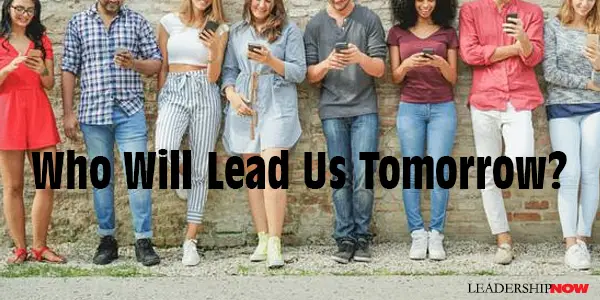
W Developing leaders places a huge responsibility on us today that goes beyond telling those future leaders what we think. To develop leaders, we must not only envision the leaders we want tomorrow, but we must behave in the manner of the leaders we want to see. We may not like the leadership or lack of it that we see today, but if our reaction to anything we don’t like is anger, outrage, hatred, and vicious rhetoric, we are endorsing those values by way of example. Unwittingly, we perpetuate hatred, outrage, and vulgarity in the leaders of tomorrow. They learn to lead by watching us “lead.” Martin Luther King succeeded because he calmly but passionately painted a picture of a world that appealed to our morality. He shared a positive idea to replace a negative idea without attacking other people. His example had moral weight. He was silenced by hatred. Hatred and anger is an idea without reason—it’s unreasonable—a rudderless opinion with no foundation. We must be the leaders we want to see developed in the generations that follow us. If you want leaders who listen, who are understanding, compassionate, civil, and respectful, then we must display those values in our dealings with what we see happening around us. If not, we are the problem. If we want others to respect us and listen to us, we must respectfully listen to them. We talk when we should be listening. If we believe people should be respectful of each other, then we must be those people. Returning in kind is tempting and sometimes funny, but it does nothing but add to the discord we see around us. Real leaders resist the temptation and rise above it. Our response should be one that is conscious and empathetic of the other person's frustration and often misplaced angst. To do anything else only adds to the destructive division we see today. Real leaders connect, they don’t divide. They focus on similarities, not differences. We often think that if I don’t yell, I won’t be heard, but we aren’t heard because we are yelling. The most strident voice is not the leader. Harsh words do not connect with others. “Blood in the streets” is not a mature response to disagreement. When we become the leaders we should be, those that follow will learn to lead the way they should. As we learn and grow, those around us will learn and grow. We are modeling now the kind of leadership we will have in the future. American poet Edwin Markham’s poem captures the need for us to grow into the leaders we want others to be: We are all blind until we see
If we want our children to be intentional about their lives, we must too be intentional about ours with the end in mind—with the consequences of our personal behavior in mind. Meaningful lives are built; they don’t just happen. If we want them to be adults, we must act like adults. We are shaping the character of future leaders today. We must resolve to be the leaders we wish to see. What will our future leaders be like? Who will lead us tomorrow? What legacy are we leaving for our children? We only need to look at ourselves.
Posted by Michael McKinney at 07:54 AM
11.05.18

Turning Observation into Innovation
E To be innovative requires a risk tolerance that most people just don’t have. It requires skills that too few have developed. We make incremental changes to be sure, but innovation necessitates something more. Often we just are too close to the situation to see the opportunities. It’s why companies like Google and Intel have called upon corporate anthropologists to bring give them fresh perspectives on their own businesses. Corporate anthropologists, like traditional anthropologists, explains Andi Simon in On the Brink, look “at a company as a new and unfamiliar culture” to arrive at fresh insights. Corporate anthropologists “see things that are really happening out there in the field, not what business leaders think is going on. They look for the deeper meaning in the interactions that make up people’s lives and the objects they surround themselves with. They search for those cultural symbols that people live by but have a hard time telling you about. And then they use their findings to help companies rethink how, and why, they’re doing things.” Andi Simon is a corporate anthropologist that wants to help you do just that—act like an anthropologist for your own organization (or life). Often on the brink of new heights, the challenge is to react appropriately to changing circumstances— “a challenge that requires seeing, feeling, and thinking in new ways.” Simon says she is amazed at how often we miss what is right in front of us. As expressed in Russell Conwell’s 1890 classic, Acres of Diamonds, “many business leaders fail to recognize that they’re sitting on acres of diamonds of unmet needs or obvious future opportunities.” There are ways to figure out our customer’s pain points and gain insights from observing both the customer and the processes of a business that lead to meaningful innovation and growth. The anthropologist’s toolkit consists of these four steps to help you change the way you see things; to find meaning in what people do or don’t do: 1. Conduct observational research. You need to go out and watch not only your customers but also your employees. Watch and record how they think and interact with your product or service. Find their pain points. “When companies cannot seem to figure out why they have stalled, customers’ pain points and headaches are often great places to start.” This is true for churches too. What questions are people asking that you aren’t answering? 2. Find out what’s coming in to you already. Users connect with you through call centers, emails, searches, your website, and networking events. What are they happy with, upset about or frustrated by? You’re looking for gaps. In the case of Centenary College, “we needed to experience the college as if we were students, to understand it as if we were their families, and to visualize it through the eyes of high school guidance counselors or a business’s human resource staff.” 3. Capture the stories. Listen. Hold listening and storytelling sessions. Records your observation with photos and videos. 4. Evaluate your culture and perhaps even change it. How does work get done in your organization? Does it fit with your strategy and goals? “As important as branding is, it is equally important that the culture is in sync with that message.” These steps are pretty straightforward and perhaps obvious, but they require some skill to implement. Simon applies these steps to seven case studies to help you see how they work in practice. The case studies will help you to look at your organization differently. 
Posted by Michael McKinney at 07:19 AM
11.02.18

David Wiener’s 40 Rules for Business, Management and the Rest of Life
I As I have matured and learned more about both business and life, I have become less economically fearful and defensive. This has made compliance with my no-jerk rule quite a bit easier. Fools, I’ve come to realize, thrive on our defensiveness, fears, and insecurities. Those qualities are to idiots what peanut butter on turkey is to rats. Know yourself and respect your own needs, and the jerks will not be able to enter your premises. Got it? Good. Now make it happen. I am approaching my fiftieth year in business. Whew! Thinking back on the lessons I learned when I was wet behind the ears, it strikes me that the technologies, financial methodologies, and expectation levels when I cashed my first paycheck were profoundly different than today. Meanwhile, the underlying interpersonal dynamics—the methods of creating and managing relationships—are fundamentally unchanged. The goal in business is to bring in more money than you spend over the long run. To do that, you need to obtain the cooperation, support, and goodwill of many people. I’m generally not sentimental; I don’t think making money was necessarily easier in the old days or that people were intrinsically nicer, more honest, or more loyal—it’s probably easier to turn a buck today than it was in earlier times. Preparation is easier today. You can learn more about the people you want to do business with by spending an hour on the internet than you could in a week making phone calls or buttonholing people. Few people become successful entirely on their own. Most successful business people are highly successful managers. The following are some of the core beliefs that have guided me in assembling, motivating, and keeping my team intact:
 
Posted by Michael McKinney at 09:18 AM
11.01.18

First Look: Leadership Books for November 2018Here's a look at some of the best leadership books to be released in November 2018. Don't miss out on other great new and future releases.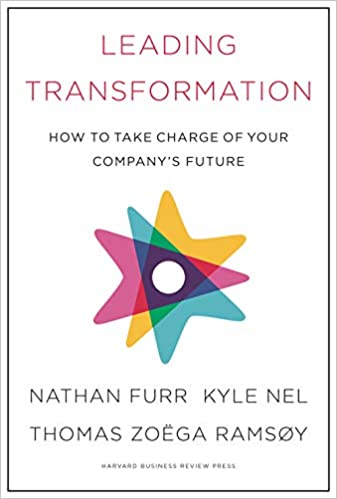  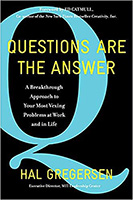 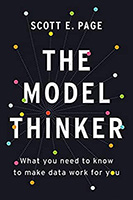 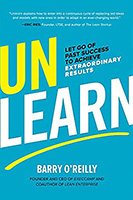
For bulk orders call 1-626-441-2024  Build your leadership library with these specials on over 39 titles. All titles are at least 40% off the list price and are available only in limited quantities. "Reading literature, more than informing us, shapes us." — Karen Swallow Prior, On Reading Well
Posted by Michael McKinney at 07:25 AM
|
BUILD YOUR KNOWLEDGE


How to Do Your Start-Up Right STRAIGHT TALK FOR START-UPS 
Grow Your Leadership Skills NEW AND UPCOMING LEADERSHIP BOOKS 
Leadership Minute BITE-SIZE CONCEPTS YOU CAN CHEW ON 
Classic Leadership Books BOOKS TO READ BEFORE YOU LEAD |
|